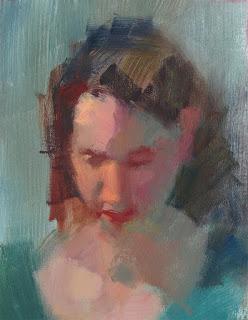
Glazing experiment

original
I'm always looking for a new way to make marks and achieve effects in oil paint, and always coming up against its one firm rule: "fat over lean". Following this rule will ensure that your paintings age as well as possible instead of cracking to pieces in a potentially short period of time; every oil painter's nightmare.
Essentially, "oilier over less oily", the fat over lean rule should be easy to apply, but it's actually very complex. A brief look at oil painting forums devoted to this subject will tell you that there are a lot of interpretations happening in studios.
If you're building a painting wet-in-wet, it's straightforward: less paint and added oil in the lower layer and more paint and added oil in the upper layers. Because oil paint is pigment bound in vegetable oil, applying a thicker layer of paint automatically means that it will be fatter (oilier) than a thin application.
I dilute my first layer with a 50/50 mix of oil and odourless mineral spirits which means that I'm adding a 1/2 fat medium to my full fat paints. The mineral spirits will evaporate out of the painting. I mix this medium with a small amount of paint and then I switch to either full oil or a fatter version of my mixture (more oil, less mineral spirits) as my medium for subsequent layers. All the while, I'm also using greater volumes of paint. Each layer is thicker and fatter than the last.
So far so good and very sound if you're always working wet in wet. But what if you want to layer paint over a dry painting? The rule is that you keep building fatter over less fat, even if the painting is dry when you add a new layer. So just keep adding thicker layers with more added oily medium than what is underneath.
Glazing, however, is a mind bender. It's an oily layer - but a small amount of paint - brushed over a dry painting to modify and unify it. So it's thin, but it's oily. This is where painters start to worry.
The safest way to apply a glaze is to brush a transparent pigment over the surface of a dry painting and then wipe it firmly away. The pigment will sit in the grooves of the brushwork but won't create a continuous skin which, being thin (hence: lean) would crack. But this method doesn't work on a smooth-surfaced painting, so painters try various mediums to achieve a glaze, and they cross their fingers that time will prove they made the right decision. Museums are full of cracking glazes, so not all decisions have proven sound.
My reading has led me to a decision about what I'm comfortable with when it comes to glazing. I plan for glazing by keeping the underpainting thinly applied and lean. Then, the glaze is mixed with an oily medium - the proportions of which will vary depending on what's underneath it, but significantly more oil than solvent or even pure oil. I have to keep scrupulous track of medium and paint thickness in the painting prior to glazing, and scrape off any paint that's gotten too thick (fat). Then, if I paint on top of the glaze, it must be with thick paint and pure oil as a medium.
That's my plan, though I'm just starting to explore glazing and will probably make more discoveries as I progress in this specialized painting method.
The painting above was an experiment over an old demo that was lying around in the studio, minding its own business. The piece was perfect for glazing because it had very little paint on it overall, and where it was thick, I could scrape it off with a sharp palette knife.
I mixed a translucent glaze of greenish-white with a medium of 75% oil mix (stand oil and oms), and brushed it over the whole piece. (If you want to get technical, this is called a velatura: an opaque glaze.)
On top of this, I added another paint layer to some areas, using thicker and oilier paint than anything that was underneath it.
I like the complex optical mixing that happens with a glaze. It also unifies a painting and softens edges in a way that alla prima painting can't.
I'll explore this further and see where it goes.
Happy painting!

